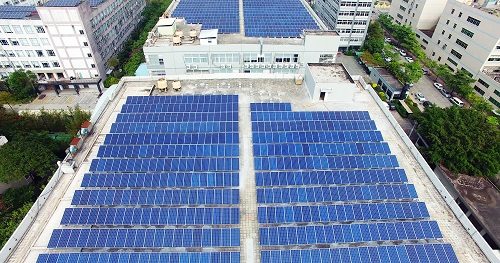Climate Change in the Big Apple: How C-PACE and Mortgage Lenders Can Help New York City Make the Climate Mobilization Act a Success
By all accounts, New York City real estate values have been significantly impaired by the COVID-19 pandemic. Thousands of businesses have suffered catastrophic economic losses, as have the landlords who own the buildings in which they operate. And without both a successful vaccine and more government stimulus, the commercial real estate industry will continue to struggle.

However, while the city tries to solve this public health crisis, there is another significant continuing challenge which will remain well after the pandemic: climate change. The Earth is still warming at an unhealthy rate because of greenhouse gas emissions. 2020 has been one of the hottest years on record so far, and the past seven years have been the seven hottest years for the planet overall.
More flooding has occurred this year as well. According to the National Oceanic and Atmospheric Administration, the southern tip of Manhattan has flooded 10 times from May 2019 to April 2020, as compared to 20 years ago when the Battery would flood less than five times per year. Sea levels are reaching all-time highs all along the Atlantic seaboard. In fact, New York is the #3 ranked city in the world in terms of risk of loss to asset value due to sea-level rise, after only Miami, Florida and Guangzhou, China.
Lawmakers in New York City acknowledged the threat of climate change with the recent passage of the Climate Mobilization Act, which will soon impose statutory limitations on the amount of carbon emissions a property can legally add to the atmosphere. One of the driving forces behind the law’s impact will be the implementation of a new commercial property assessed clean energy (“C-PACE”) lending program designed to finance energy-efficient improvements and thus drive down carbon footprints. The degree to which C-PACE will prove to be an effective catalyst in making the city greener will depend in large part on whether mortgage lenders will allow their real estate collateral to be encumbered by the special assessments created by C-PACE financing.
In this article, we will:
- discuss the Climate Mobilization Act and the requirements set forth in Local Law 97 for decreasing the carbon emissions of New York City buildings;
- summarize the legal structure and practical benefits of C-PACE financing; and
- explain how first mortgage lenders, including those originating loans intended to be bundled, tranched and sold as bonds in a commercial mortgage-backed securitization (CMBS), can structure their financings to accommodate a C-PACE financing.
With some careful drafting and targeted due diligence, lenders can minimize the risk to their collateral while achieving other beneficial goals. By consenting to the C-PACE financing, they will help their borrowers incur lower operating expenses, drive up property values and operate more energy-efficient buildings. Together, bankers and property owners can be part of the climate change solution.
The Climate Mobilization Act

In May 2019, the New York City Council passed the Climate Mobilization Act (the “Act”). One of the most important parts of the Act, Local Law 97, requires all new and existing buildings larger than 25,000 square feet to reduce their carbon emissions by 40% by the year 2030, and by 80% by the year 2050. There are over one million buildings in New York City, and this law will apply to the largest 50,000 of that total. Buildings are the city’s largest source of greenhouse gas emissions, accounting for roughly 70% of emissions, primarily from generating electricity for lights and appliances and burning oil and gas for heat and hot water.
C-PACE in New York City

It is clear that many New York City building owners will need to make a number of green improvements to their properties in order to comply with the Act. Hopefully soon, the owner/developer community will be able to look to C-PACE financing as a way to meet their Local Law 97 emissions reduction targets. Local Law 96, which was also included in the Act, enabled C-PACE financing in New York City for the first time. The program cannot be established, however, until the city first issues draft rules and then allows for a public review and comment period. These rules will ultimately create the framework for how the program will be administered on a day-to-day basis by the city. The New York City Energy Efficiency Corporation, a non-profit body that will administer New York City’s C-PACE program, was due to begin accepting loan applications in early 2020. However, the roll-out has stalled by the COVID-19 pandemic. While we wait for the details of New York City’s C-PACE program to be formally enacted, a general overview of how C-PACE lending works is summarized as follows.
Mortgage Lenders and C-PACE

Mortgage lenders, including CMBS lenders, customarily do not allow any type of additional financing on the underlying property securing their loans. This concern is most strict with respect to any other debt that would be superior to, or equal in priority to, the mortgage lien. Given their special lien priority status, most commercial mortgage loan documents prohibit the borrower from taking out a C-PACE loan. In fact, the mortgage loan documents typically provide that C-PACE loans are expressly prohibited without the prior written consent of the mortgage lender. Accordingly, C-PACE loans constitute prohibited indebtedness that would give rise to an event of default under the mortgage loan. A C-PACE loan in violation of the loan documents would also trigger recourse liability to the sponsor under a typical non-recourse carve-out guaranty. However, the risk to mortgage lenders in approving a C-PACE financing is low if the right structural mitigants are hardwired into the loan documents. As a result, the categorical ban by mortgage lenders on C-PACE loans should be reevaluated, especially in New York City in light of the Act and Local Law 97. There are many prudent changes mortgage lenders can make to their loan documents to minimize the risk of a C-PACE loan defaulting and priming the mortgage loan.
Loan Documents
With respect to the loan documents themselves, mortgage lenders should consider adding the following inserts to their form loan agreements to allow for C-PACE financing that exists as of the origination date of the loan. Similar changes should also be made to the mortgage, recourse guaranty and environmental indemnity agreement, as applicable.
-
- “C-PACE Loan” shall mean the financing secured by the Property made pursuant to the C-PACE Loan Documents.”
- “C-PACE Loan Documents” shall mean those certain financing documents listed on Exhibit [__] attached hereto.”
- “C-PACE Loan” shall mean the financing secured by the Property made pursuant to the C-PACE Loan Documents.”
-
- “Borrower hereby represents as of the Closing Date that (a) the C-PACE Loan was made on [______], 20[__] to finance the cost of [_____________], [which improvements have been completed as of the date hereof,] (b) the current outstanding principal balance of the C-PACE Loan is $[______], (c) the C-PACE Loan Documents are in full force and effect and have not been amended, restated, replaced or otherwise modified (except, in each case, as expressly set forth herein), (d) there are no defaults under the C-PACE Loan Documents by any party thereto and, to Borrower’s knowledge, no event has occurred which, but for the passage of time, the giving of notice, or both, would constitute a default under the C-PACE Loan Documents, (e) all amounts due and payable under the C-PACE Loan Documents have been paid in full, (f) no party to the C-PACE Loan Documents has commenced any action or given or received any notice for the purpose of terminating the C-PACE Loan Documents, (g) the representations made in any estoppel or similar document delivered with respect to the C-PACE Loan Documents in connection with the Loan are true, complete and correct and are hereby incorporated by reference as if fully set forth herein, and (h) Borrower knows of no basis for any additional assessment relating to the C-PACE Loan other than as set forth in the C-PACE Loan Documents.”
-
- “Borrower shall (i) pay all amounts due and owing under the C-PACE Loan Documents as the same become due and payable, and perform all of the covenants and agreements required to be performed under the C-PACE Loan Documents; (ii) promptly notify Lender of any default under the C-PACE Loan Documents; (iii) promptly deliver to Lender a copy of any notice received by it under the C-PACE Loan Documents; (iv) enforce the performance and observance of all of the covenants and agreements required to be performed and/or observed under the C-PACE Loan Documents; (v) cause the Property to be operated in accordance with the C-PACE Loan Documents; and (vi) not, without the prior written consent of Lender, (A) enter into any new C-PACE Loan Documents or replace or execute modifications to any existing C-PACE Loan Documents or renew or extend the same, (B) surrender, terminate or cancel the C-PACE Loan Documents, (C) reduce or consent to the reduction of the term of the C-PACE Loan Documents, (D) increase or consent to the increase of the amount of any charges under the C-PACE Loan Documents, or (E) following the occurrence and during the continuance of an Event of Default, exercise any rights, make any decisions, grant any approvals or otherwise take any action under the C-PACE Loan Documents.”
- “Borrower shall deliver to Lender, within ten (10) days of request, estoppel certificates from each party under any C-PACE Loan Documents in form and substance acceptable to Lender.”
- “Borrower shall (i) pay all amounts due and owing under the C-PACE Loan Documents as the same become due and payable, and perform all of the covenants and agreements required to be performed under the C-PACE Loan Documents; (ii) promptly notify Lender of any default under the C-PACE Loan Documents; (iii) promptly deliver to Lender a copy of any notice received by it under the C-PACE Loan Documents; (iv) enforce the performance and observance of all of the covenants and agreements required to be performed and/or observed under the C-PACE Loan Documents; (v) cause the Property to be operated in accordance with the C-PACE Loan Documents; and (vi) not, without the prior written consent of Lender, (A) enter into any new C-PACE Loan Documents or replace or execute modifications to any existing C-PACE Loan Documents or renew or extend the same, (B) surrender, terminate or cancel the C-PACE Loan Documents, (C) reduce or consent to the reduction of the term of the C-PACE Loan Documents, (D) increase or consent to the increase of the amount of any charges under the C-PACE Loan Documents, or (E) following the occurrence and during the continuance of an Event of Default, exercise any rights, make any decisions, grant any approvals or otherwise take any action under the C-PACE Loan Documents.”
-
- It shall be an Event of Default “if (A) Borrower shall fail (beyond any applicable notice or grace period) to pay any assessments or other charges payable under any C-PACE Loan Documents as and when payable thereunder, (B) Borrower defaults under the C-PACE Loan Documents beyond the expiration of applicable notice and grace periods, if any, thereunder, (C) if the Property becomes subject to any lien on account of the C-PACE Loan Documents, or (D) any of the C-PACE Loan Documents are amended, supplemented, replaced, restated or otherwise modified without Lender’s prior written consent.”
-
- The C-PACE Loan shall be both a “Permitted Transfer” and a “Permitted Encumbrance.”
-
- It shall be an event giving rise to recourse liability to the extent of any losses suffered by Lender in connection with “(A) any violation or breach of the C-PACE Loan Documents, or (B) if Borrower’s failure to pay any amounts due and payable under the C-PACE Loan Documents creates any lien on the Property.”
- It shall be an event giving rise to recourse liability for the full amount of the mortgage loan debt if “any of the C-PACE Loan Documents are amended, supplemented, replaced, restated or otherwise modified without Lender’s prior written consent or Borrower fails to obtain Lender’s prior written consent to any additional C-PACE financing.”
Conclusion
While still dealing with the pandemic, the New York City commercial real estate market is at a crossroads. When will workers permanently return to their Midtown offices, either full-time or under a hybrid arrangement? Will companies downsize their office space? When will 5th Avenue retail and 90%+ hotel occupancy come back? When will Madison Square Garden and Broadway reopen to thousands of spectators? While the answers to these questions are up for debate, no one doubts that the New York City market will prove its resiliency once again, adjusting and evolving, and one day soon returning to full health as one of the strongest in the world.
Although the pandemic has forced New York City and much of society around the globe into varying degrees of quarantine and shutdowns, and put on hold many lives and businesses, climate change has not stopped. The burning of fossil fuels by human activity is warming our planet at a dangerous rate. It has been reported that global emissions fell by 17% in April 2020 because of the lockdowns, and in New York City the reduction was closer to 30% in light of reduced occupancy. However, as countries and states started loosening restrictions and re-opening their economies, greenhouse gas levels quickly rebounded to at or near pre-pandemic levels. The Climate Mobilization Act will empower New York City to fight back against climate change. And once put into effect, the city’s C-PACE financing program will serve as an effective tool in this fight. It will help property owners who are experiencing cash flow shortfalls caused by the pandemic to create greener buildings which will lower operating expenses and increase property values over time.
As one prominent climate change expert aptly put it, if you think of COVID-19 as the planet’s pop quiz, then climate change must be considered the final exam. With the support (and the prior written consent) of mortgage lenders, C-PACE financing will help New York City pass with honors.


